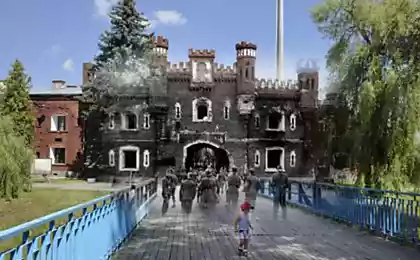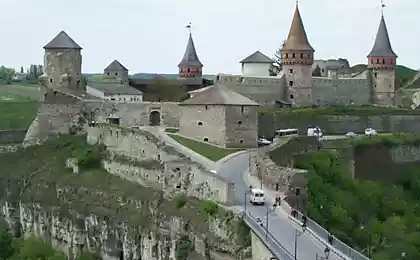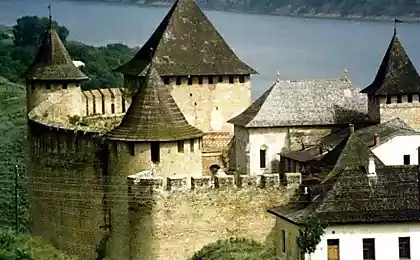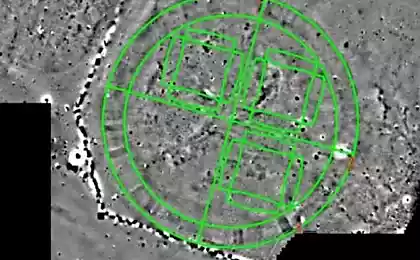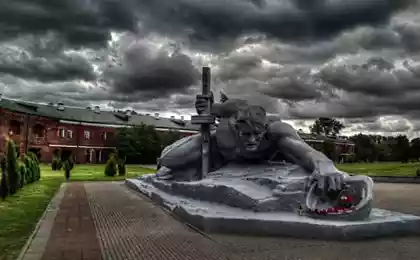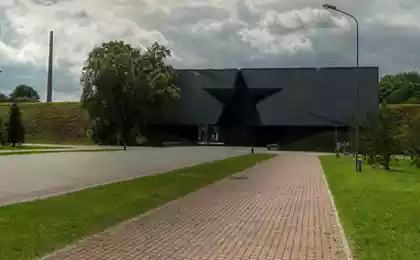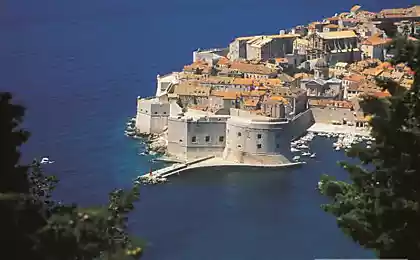1318
Powerful fortress in Landskrona
The existence of a fortress in Landskrona Swedish authorities are obliged to their rivals from Denmark: southern Sweden has repeatedly passed from hand to hand, with both sides well in my own way believed that its territory. The next stage of the confrontation came in the reign of King Christian III, whose engineers have tried their best, having arranged unusually powerful stronghold erected with the latest fortification thought the middle of the XVI century.

Available as a zigzagging defenders were bastions, suitable for conducting flanking fire and the moat, dungeons barracks, outbuildings in case of a long siege, and other designs. That's just all this military splendor not handy or the Danes or Swedes who had replaced them: in active combat Fortress did not participate. It is, if you look on the other hand, even good, because now we can see the building in all its primeval power, without cuts or later "inserts».

The fortress was originally conceived it as a fortress, not a magnificent palace with a heightened defenses. She was not even fit for living, but in 1589 the local governor and ordered to attach to the fortress a small residential wing.
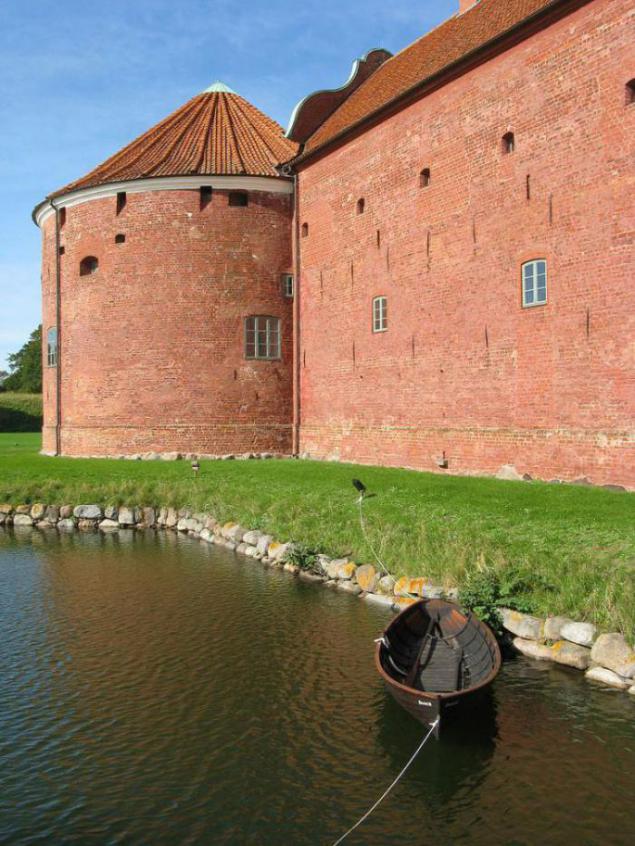
At the same time gets the baton in battle of Swedes and Danes over the land: in 1644 it is in the hands of the Swedes, but only for a year. After the Roskilde peace treaty in 1658, it reverts to the Swedes. This time the Swedes did not waste time: in 1667 and 1675 years. are in construction work, which resulted in the castle becomes the latest.

However, a year later, a new war between Denmark and Sweden reached. For the defense of the fortress commander responsible Swedish Hieronimus Lindeberg, circle 1600 highly skilled and dedicated his soldiers. Danes begin the siege of the fortress, and a few days literally showered e cannonballs. And then - to the surprise of all - Lindeberg otdat the order to surrender. Danes belong to the citadel, which from that moment becomes the most important defensive point of the southern neighbor Sweden.

During commissioning, regarded as treason, Lindeberg was brought before a military tribunal - no one could understand why the commandant passed the mighty fortress, instead of "fight to the last man." In its justification Lindeberg only said that his wife was sorry to say: oglushayugtsy noise exploding shells acted on her nerves, and she can not bear it, compelled her husband to surrender.

people, however, caught another version: Lindeberg, negotiating with the Danes, asked about the possibility of the castle to send his sick wife, but was refused. But his wife found out about it, fear has given birth to twins, but she died in childbirth. Distraught with grief and despair Lindeberg could hardly give an account of his actions and the fortress surrendered without a battle. I must say that the rumors about the death of his wife had been greatly exaggerated: it is much survived her husband, and even received a pension from the royal treasury as a widow.
Lindeberg was executed in December 1677 Two years later, again in the hands of the Swedes.

In general, about the citadel tell many interesting stories. For example, in 1685 the locals started growing outrage at the fact that their job was to continually release the ditches ice - is unfair that those same neighbors landskruntsev not involved in such work Then the king issued a decree to recover from residents the neighboring city of Helsingborg in favor of an annual tribute of 30 Daler silver - a measure that made a long time "ice" discord in relations between neighbors.

Another story, causing some compassion and empathy, some - laughter is associated with one of the most famous in Sweden animals - elk. Danish astronomer, astrologer and alchemist (1546-1601) said in a letter dating back to 1591, in his castle lived Landskrunskom handmade moose. Once in Landskrona was a dinner party, and moose entered the hall to show guests. Guests can not fail to fill their glasses to Krav and treat pet very strong drinks. Elk, without calculating the forces could not resist long legs and fell down the stairs and broke his leg at the same time. Although due care and effort, animal life could not be saved, and the favorite, died in the castle in agony from a hangover, and leg pain.
In 1724 priznatsya best defensive strengthening of Sweden, but this did not prevent the king 20 years later issued a secret decree on the construction of additional facilities around the bastion. The main task was to protect the monarch Sun sprawling harbor, and therefore the central place of work was chosen the eastern end of shelf - Groen (Graon)

However, each year the work demanded more money Sun - initially on a new fortress was allocated five barrels of gold, but it soon became clear that the final costs will cost the treasury more than 300 barrels! In addition, the pace of work left much to be desired, according to preliminary raschtam project was to be zavershn to 2110 is estimated construction commission stated furthermore that is no longer the most important border crossing point, as requiring a thorough strengthening as before - now it was quite possible do a little upgrading of the old bastion.

However, the Swedes took esch half a century, to permanently stop the start of construction. Around the same time to appear the first zaklyuchnnye; since 1827 there are hundreds osuzhdnnyh life, and at the beginning of the XX century. here we brought to the women's correctional labor lgkogo behavior. After World War II became a bastion of temporary shelter for the refugees, whose number in 1953 reached 22000.
In recent years, the company is famous citadel lush holidays, a restaurant with delicious dishes and museum exhibition devoted to the history of the fortress.

Entrance to the fort is free, so it is not forbidden in the daytime to go to the territory on a wooden bridge and look at the countryside. In addition, the ridges bastions offers a good view of the countryside - very close to the shore of the Baltic Sea.

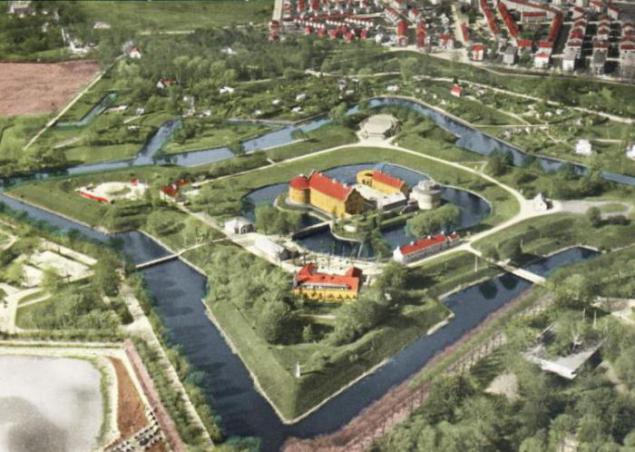
But the interesting thing, when I was looking for information on the Internet about this fortress, I in 90% of cases come across yet another similar fortress - Landskrona - castle, founded by the Swedes at the mouth of the Okhta River in 1300. In 1301, taken by Russian troops and completely destroyed. Coordinates: 59 ° 56'39 "with. w. 30 ° 24'25 "c. d. / 59.944167 ° c. w. 30.406944 ° c. d. 59.944167, 30.406944
During the excavation in 2008 it was found on this site Neolithic settlement with the burial of 90 people (presumably Indo-European identity), household items. So far, it remains unclear why the settlers of that time chose this island between two rivers, but the fact remains.
The Novgorod Chronicle senior and junior plagued said that in 1300 at the mouth of the Neva Swedes laid the fortress, "utverdisha its hardness unspeakable." He makes it "deliberate" Master, who was a native of Rome. That is, this castle two centuries ahead of the work of Italian architects who, Ivan III invited to Moscow to build the Kremlin. Nienschanz is the earliest of the Italian fortress, built on the territory of ancient Russia.
But why did the Swedes, are hosted in these places, to invite the Italians (who were considered an unsurpassed master of fortification at that time) ??? And why was the "Fortress hardness unspeakable» ???

After the conquest by the Swedes in the second half of the XII - the first half of the XIII century, South-Western and Central Finland, their expansion was halted for several decades. A new series of Russian-Swedish clashes began only in the 80's of the XIII century. In 1283, the Swedes, having passed through the Neva, raided Novgorod lands, but on the way back were intercepted Novgorod on the river Neva. The following year a new unit was defeated by Novgorod Swedes at the mouth of the Neva. 1292 was marked by mutual raids Russian and Swedish.
Third Swedish Crusade in 1293 marked the beginning of a new phase of hostilities. The official purpose of the campaign was an appeal "pagans" to the Christian faith, the real - to strengthen the Swedish supremacy in the South West of Karelia. As a result of the campaign it was founded by the city of Vyborg, long a center of Swedish rule. Soon, under his authority were 14 Karelian communities. City caught a bustling trade route along the river Vuoksi was walking from the Baltic Sea to Lake Ladoga and threatened the mouth of the Neva River former Russian main outlet to the sea. Because vnutrirusskih strife Novgorod managed to organize a march to Vyborg only in winter 1294, but even then they were able to highlight for him relatively little force, resulting in the campaign was a failure.
In 1295 the Swedes tried to gain a foothold on the other side of the waterway Vuoksinskie capturing Korela town, located on the second mouth of the River Vuoksi, which flows into Lake Ladoga. Thus the Swedes not only strengthened its dominance on the Karelian Isthmus, but also cut off the Finnish tribes from direct communication with the Novgorod Republic. Taught by bitter experience, Novgorod immediately sent an army, took the city and killed the entire garrison, from which only two people survived.
Having failed in the Lake Ladoga, the Swedes decided to move the point of impact on the banks of the Neva. Capture the main exit to the sea put the Russian under Swedish control all trade and economic life of Novgorod the Great, and a large part of Russia.

Novgorod in those years had no fortifications at the mouth of the Neva. The nearest fortress was, Ladoga and Korela to the mouth of the Neva was two or three days' journey, and the road from Novgorod took more than a week. Content Russian fortress there should be major costs and at the same time it is constantly exposed to the danger of being captured from the sea.
Swedes plan lay in the fact that during the summer season, under the guise of a large force to build a strong fortress, the garrison of which will be able to withstand the attack of Novgorod during the winter, when the bulk of the Swedish troops will return to Sweden.
The Swedes have decided to consolidate the territory with the help of the fortified settlement here, like it is here to assert his authority to have its way out of the Neva River to the Baltic, to influence the trade routes. This is a strategically important position. The so-called "Baltic question" - Russia and Sweden it solves many centuries. First planted fortress "Landskrona" (Crown of the Earth in its transferring title to stand up to that time there Novgorod village - Venchische) was a stone-wood, and a year later, she was taken by Novgorod, led by the son of Alexander Yaroslavich (Nevsky) Prince Andrei Gorodetsky after which it was destroyed.
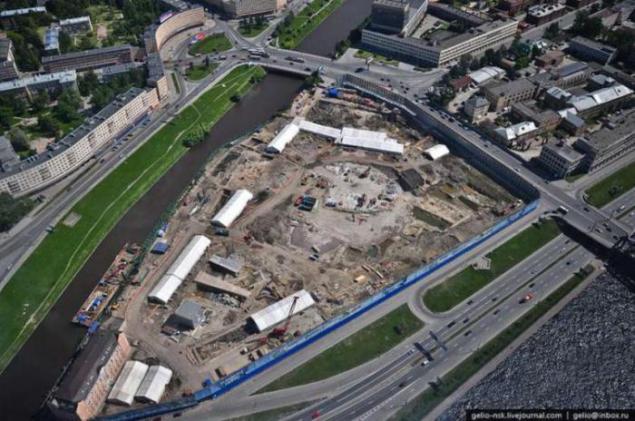
It is understandable, for it alerted Novgorod authorities, because in front of everyone was cut off a piece of government Novgorod. It was a terrible move by the Swedish Government, the answer to which is not long in coming.
It's hard to say for sure exactly when, after the destruction of Landskrona was re-inhabited this land, but scribe books Vodskaya fifths in 1500 situated therein mentioned trade settlement, "small village Ust Ohta on the Neva»
Further historical references to the events surrounding Nyenskans disappear, apparently had no time to princes Russian solve territorial issues tending more and more to the internal strife.
However, since the beginning of 1702 to set up Peter shipyards in Lodeynoye Pole on the Svir river and on the river Syas began construction of military vessels. In 1703 the first Baltic squadron of frigates 6 was launched. At the end of April 1703 infantry with artillery detachment, and published in the Neva fleet launched an attack on Nienschanz. April 26 he went out at the mouth of the Neva River and landed on the island Vitusaari (Gutuevom) three companies. These Swedes he closed the entrance to the Gulf of Finland to the Neva. Russian troops landed at Nyenskans, captured external earthworks installed artillery and bombarded for 10 hours fortress. May 1, 1703 Nienschanz surrendered, and under the terms of the surrender of the garrison left the fortress; residents were captured. Nienschanz Peter renamed Shlotburg ("city of the castle»).
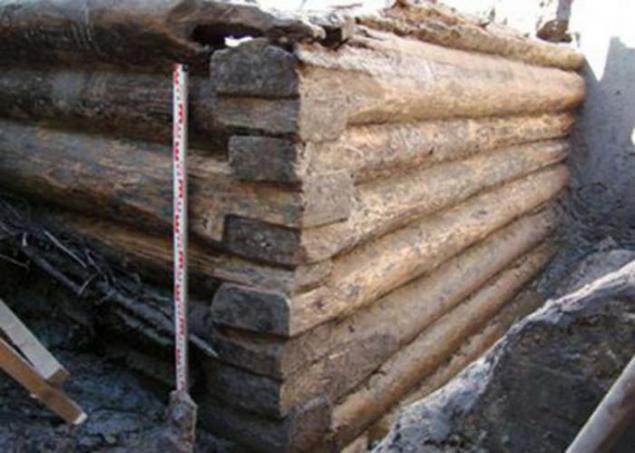
In the history of this and that the settlement ended its run, and Peter with a small army went up the Neva River to the island Enisaari (Rabbit), where 16 (27) in May 1703 laid the fortress.
Here is how this event chronicler:
Then ditch was dug about two yards in him, May 16, 1703 (old style), the day of the Holy Trinity, the box set, carved out of stone. King covered box stone plaque with the inscription: "From the Incarnation of Jesus Christ in 1703, May 16, founded the imperial city of St. Petersburg the Great Emperor, King and Grand Duke Peter Alekseevich, Autocrat Vserossiykim».
Was made cannon firing ...
... There was a secondary firing cannon and between those two peals King deigned to mark where to be the goal. Peter ordered to punch two holes in the ground and cut down two birch subtle but dlinnyya, and tops of the birches convolution, and supplied to the ends of the punched holes on the similarity of the gate.
And when the first of a birch tree in the ground adopted, the other supplied, then an eagle, dropping from a height, sat on the add gate; Corporal Odintsov thereof eagle with a goal shot.
Okhta Cape, and the land around it is constantly passed from Russian Swedes and back. The fortress of Landskrona, which the Swedes built in 1300, a year burned and destroyed the son of Alexander Nevsky, Prince Andrei Gorodetsky. Its foundations were found during the excavation, wooden and rectangular plan. Landskorna was a great reinforcement, only one of its southern wall to a length of 100 meters. It was about twice the size of the Vyborg fortress, built in the 7 years before and, as the Chronicle, was involved in the construction of the master of Rome. So this is the first Italian fortress built on Russian territory, 200 years older than Moscow Kremlin - concludes PhD and teacher Peter Sorokin Anatoly Kirpichnikov (although we should not forget that the fortress, in contrast to the Kremlin were built, of course, not Russian, and the Swedes against Russian ... but still).
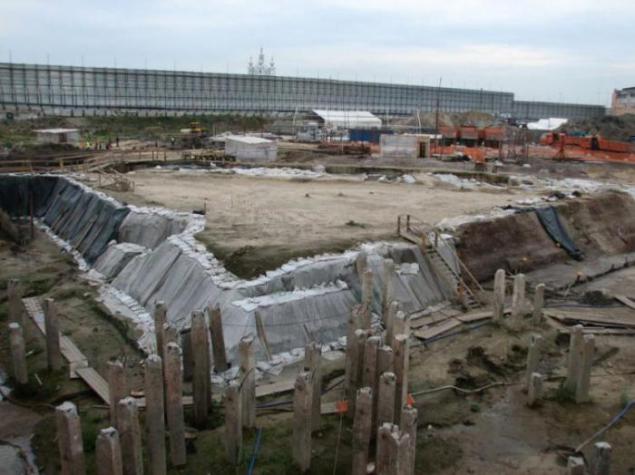
As it turned out during the excavation, Landskrona was surrounded by two parallel lines of trenches, depth of two meters and a width of about three. Over the moat was a stream (or flow), which was used as an additional natural barrier. Inside the fortress found the remains of three burnt, most likely during the assault, wooden buildings. And in the western part of the archeologists discovered very well-preserved frame - base square fortress towers, observation, or even dungeon, strengthening housing (inside the tower found the remains of the well). Perhaps this framework is the "Pogrebnaya Tower", where, according to "The Chronicles of Erik" Swedish defenders of the city were locked from Novgorod before the final surrender. Log cabin 1300 could well be removed from the land and moved to the museum.
After some time after the fall of the Swedish Landskrona Cape took Russian trade settlement "Neva estuary"; Swedes called him Nien. At the end of the XVI century there was a courtyard seating, a marina, and the Orthodox Church. However, the trenches of the XIV century, at least partially, but preserved and possibly used. In the Time of Troubles, the land went back to the Swedes, who in 1611 built a new fortress Nienschanz here. From this, the first Nyenskans remains of the bastion system and laying turf at the base of the shaft. The second was built after the steward Potemkin took and destroyed, but could not hold the fort in 1656. Between 1661 and 1677 the Swedes built a fortress in the form of a five-pointed star with five bastions (the peak achievements of the then fortification fortresses known in Europe quite a lot). Around the fortress, new ditches, and inside - stone and wooden buildings.
Archaeologists have explored three bastions, Charles, Dead and Gelmfeltov, the moat and the curtain between them, a platform for shooting during the siege; We discovered the secret passage to the metal strips studded wooden door. Inside the fortress found stone building with a smelting furnace; its floor was paved with boulders. In the pits showed core fragments of shells, mortirnye bombs weighing up to 75 kilograms, apparently left over from the last battle with Peter I in 1703.
Now there is some sort of a confusing situation, "Gazprom" has invested a lot of money in the project, paid for the excavation now can not build there. It seems to be good (not to Gazprom), but the results of the excavation is necessary as that to preserve or build the museum complex. It has no money and does not give it all breaks down slowly, guttering and mixed in the mud.

Available as a zigzagging defenders were bastions, suitable for conducting flanking fire and the moat, dungeons barracks, outbuildings in case of a long siege, and other designs. That's just all this military splendor not handy or the Danes or Swedes who had replaced them: in active combat Fortress did not participate. It is, if you look on the other hand, even good, because now we can see the building in all its primeval power, without cuts or later "inserts».

The fortress was originally conceived it as a fortress, not a magnificent palace with a heightened defenses. She was not even fit for living, but in 1589 the local governor and ordered to attach to the fortress a small residential wing.

At the same time gets the baton in battle of Swedes and Danes over the land: in 1644 it is in the hands of the Swedes, but only for a year. After the Roskilde peace treaty in 1658, it reverts to the Swedes. This time the Swedes did not waste time: in 1667 and 1675 years. are in construction work, which resulted in the castle becomes the latest.

However, a year later, a new war between Denmark and Sweden reached. For the defense of the fortress commander responsible Swedish Hieronimus Lindeberg, circle 1600 highly skilled and dedicated his soldiers. Danes begin the siege of the fortress, and a few days literally showered e cannonballs. And then - to the surprise of all - Lindeberg otdat the order to surrender. Danes belong to the citadel, which from that moment becomes the most important defensive point of the southern neighbor Sweden.

During commissioning, regarded as treason, Lindeberg was brought before a military tribunal - no one could understand why the commandant passed the mighty fortress, instead of "fight to the last man." In its justification Lindeberg only said that his wife was sorry to say: oglushayugtsy noise exploding shells acted on her nerves, and she can not bear it, compelled her husband to surrender.

people, however, caught another version: Lindeberg, negotiating with the Danes, asked about the possibility of the castle to send his sick wife, but was refused. But his wife found out about it, fear has given birth to twins, but she died in childbirth. Distraught with grief and despair Lindeberg could hardly give an account of his actions and the fortress surrendered without a battle. I must say that the rumors about the death of his wife had been greatly exaggerated: it is much survived her husband, and even received a pension from the royal treasury as a widow.
Lindeberg was executed in December 1677 Two years later, again in the hands of the Swedes.

In general, about the citadel tell many interesting stories. For example, in 1685 the locals started growing outrage at the fact that their job was to continually release the ditches ice - is unfair that those same neighbors landskruntsev not involved in such work Then the king issued a decree to recover from residents the neighboring city of Helsingborg in favor of an annual tribute of 30 Daler silver - a measure that made a long time "ice" discord in relations between neighbors.

Another story, causing some compassion and empathy, some - laughter is associated with one of the most famous in Sweden animals - elk. Danish astronomer, astrologer and alchemist (1546-1601) said in a letter dating back to 1591, in his castle lived Landskrunskom handmade moose. Once in Landskrona was a dinner party, and moose entered the hall to show guests. Guests can not fail to fill their glasses to Krav and treat pet very strong drinks. Elk, without calculating the forces could not resist long legs and fell down the stairs and broke his leg at the same time. Although due care and effort, animal life could not be saved, and the favorite, died in the castle in agony from a hangover, and leg pain.
In 1724 priznatsya best defensive strengthening of Sweden, but this did not prevent the king 20 years later issued a secret decree on the construction of additional facilities around the bastion. The main task was to protect the monarch Sun sprawling harbor, and therefore the central place of work was chosen the eastern end of shelf - Groen (Graon)

However, each year the work demanded more money Sun - initially on a new fortress was allocated five barrels of gold, but it soon became clear that the final costs will cost the treasury more than 300 barrels! In addition, the pace of work left much to be desired, according to preliminary raschtam project was to be zavershn to 2110 is estimated construction commission stated furthermore that is no longer the most important border crossing point, as requiring a thorough strengthening as before - now it was quite possible do a little upgrading of the old bastion.

However, the Swedes took esch half a century, to permanently stop the start of construction. Around the same time to appear the first zaklyuchnnye; since 1827 there are hundreds osuzhdnnyh life, and at the beginning of the XX century. here we brought to the women's correctional labor lgkogo behavior. After World War II became a bastion of temporary shelter for the refugees, whose number in 1953 reached 22000.
In recent years, the company is famous citadel lush holidays, a restaurant with delicious dishes and museum exhibition devoted to the history of the fortress.

Entrance to the fort is free, so it is not forbidden in the daytime to go to the territory on a wooden bridge and look at the countryside. In addition, the ridges bastions offers a good view of the countryside - very close to the shore of the Baltic Sea.


But the interesting thing, when I was looking for information on the Internet about this fortress, I in 90% of cases come across yet another similar fortress - Landskrona - castle, founded by the Swedes at the mouth of the Okhta River in 1300. In 1301, taken by Russian troops and completely destroyed. Coordinates: 59 ° 56'39 "with. w. 30 ° 24'25 "c. d. / 59.944167 ° c. w. 30.406944 ° c. d. 59.944167, 30.406944
During the excavation in 2008 it was found on this site Neolithic settlement with the burial of 90 people (presumably Indo-European identity), household items. So far, it remains unclear why the settlers of that time chose this island between two rivers, but the fact remains.
The Novgorod Chronicle senior and junior plagued said that in 1300 at the mouth of the Neva Swedes laid the fortress, "utverdisha its hardness unspeakable." He makes it "deliberate" Master, who was a native of Rome. That is, this castle two centuries ahead of the work of Italian architects who, Ivan III invited to Moscow to build the Kremlin. Nienschanz is the earliest of the Italian fortress, built on the territory of ancient Russia.
But why did the Swedes, are hosted in these places, to invite the Italians (who were considered an unsurpassed master of fortification at that time) ??? And why was the "Fortress hardness unspeakable» ???

After the conquest by the Swedes in the second half of the XII - the first half of the XIII century, South-Western and Central Finland, their expansion was halted for several decades. A new series of Russian-Swedish clashes began only in the 80's of the XIII century. In 1283, the Swedes, having passed through the Neva, raided Novgorod lands, but on the way back were intercepted Novgorod on the river Neva. The following year a new unit was defeated by Novgorod Swedes at the mouth of the Neva. 1292 was marked by mutual raids Russian and Swedish.
Third Swedish Crusade in 1293 marked the beginning of a new phase of hostilities. The official purpose of the campaign was an appeal "pagans" to the Christian faith, the real - to strengthen the Swedish supremacy in the South West of Karelia. As a result of the campaign it was founded by the city of Vyborg, long a center of Swedish rule. Soon, under his authority were 14 Karelian communities. City caught a bustling trade route along the river Vuoksi was walking from the Baltic Sea to Lake Ladoga and threatened the mouth of the Neva River former Russian main outlet to the sea. Because vnutrirusskih strife Novgorod managed to organize a march to Vyborg only in winter 1294, but even then they were able to highlight for him relatively little force, resulting in the campaign was a failure.
In 1295 the Swedes tried to gain a foothold on the other side of the waterway Vuoksinskie capturing Korela town, located on the second mouth of the River Vuoksi, which flows into Lake Ladoga. Thus the Swedes not only strengthened its dominance on the Karelian Isthmus, but also cut off the Finnish tribes from direct communication with the Novgorod Republic. Taught by bitter experience, Novgorod immediately sent an army, took the city and killed the entire garrison, from which only two people survived.
Having failed in the Lake Ladoga, the Swedes decided to move the point of impact on the banks of the Neva. Capture the main exit to the sea put the Russian under Swedish control all trade and economic life of Novgorod the Great, and a large part of Russia.

Novgorod in those years had no fortifications at the mouth of the Neva. The nearest fortress was, Ladoga and Korela to the mouth of the Neva was two or three days' journey, and the road from Novgorod took more than a week. Content Russian fortress there should be major costs and at the same time it is constantly exposed to the danger of being captured from the sea.
Swedes plan lay in the fact that during the summer season, under the guise of a large force to build a strong fortress, the garrison of which will be able to withstand the attack of Novgorod during the winter, when the bulk of the Swedish troops will return to Sweden.
The Swedes have decided to consolidate the territory with the help of the fortified settlement here, like it is here to assert his authority to have its way out of the Neva River to the Baltic, to influence the trade routes. This is a strategically important position. The so-called "Baltic question" - Russia and Sweden it solves many centuries. First planted fortress "Landskrona" (Crown of the Earth in its transferring title to stand up to that time there Novgorod village - Venchische) was a stone-wood, and a year later, she was taken by Novgorod, led by the son of Alexander Yaroslavich (Nevsky) Prince Andrei Gorodetsky after which it was destroyed.

It is understandable, for it alerted Novgorod authorities, because in front of everyone was cut off a piece of government Novgorod. It was a terrible move by the Swedish Government, the answer to which is not long in coming.
It's hard to say for sure exactly when, after the destruction of Landskrona was re-inhabited this land, but scribe books Vodskaya fifths in 1500 situated therein mentioned trade settlement, "small village Ust Ohta on the Neva»
Further historical references to the events surrounding Nyenskans disappear, apparently had no time to princes Russian solve territorial issues tending more and more to the internal strife.
However, since the beginning of 1702 to set up Peter shipyards in Lodeynoye Pole on the Svir river and on the river Syas began construction of military vessels. In 1703 the first Baltic squadron of frigates 6 was launched. At the end of April 1703 infantry with artillery detachment, and published in the Neva fleet launched an attack on Nienschanz. April 26 he went out at the mouth of the Neva River and landed on the island Vitusaari (Gutuevom) three companies. These Swedes he closed the entrance to the Gulf of Finland to the Neva. Russian troops landed at Nyenskans, captured external earthworks installed artillery and bombarded for 10 hours fortress. May 1, 1703 Nienschanz surrendered, and under the terms of the surrender of the garrison left the fortress; residents were captured. Nienschanz Peter renamed Shlotburg ("city of the castle»).

In the history of this and that the settlement ended its run, and Peter with a small army went up the Neva River to the island Enisaari (Rabbit), where 16 (27) in May 1703 laid the fortress.
Here is how this event chronicler:
Then ditch was dug about two yards in him, May 16, 1703 (old style), the day of the Holy Trinity, the box set, carved out of stone. King covered box stone plaque with the inscription: "From the Incarnation of Jesus Christ in 1703, May 16, founded the imperial city of St. Petersburg the Great Emperor, King and Grand Duke Peter Alekseevich, Autocrat Vserossiykim».
Was made cannon firing ...
... There was a secondary firing cannon and between those two peals King deigned to mark where to be the goal. Peter ordered to punch two holes in the ground and cut down two birch subtle but dlinnyya, and tops of the birches convolution, and supplied to the ends of the punched holes on the similarity of the gate.
And when the first of a birch tree in the ground adopted, the other supplied, then an eagle, dropping from a height, sat on the add gate; Corporal Odintsov thereof eagle with a goal shot.
Okhta Cape, and the land around it is constantly passed from Russian Swedes and back. The fortress of Landskrona, which the Swedes built in 1300, a year burned and destroyed the son of Alexander Nevsky, Prince Andrei Gorodetsky. Its foundations were found during the excavation, wooden and rectangular plan. Landskorna was a great reinforcement, only one of its southern wall to a length of 100 meters. It was about twice the size of the Vyborg fortress, built in the 7 years before and, as the Chronicle, was involved in the construction of the master of Rome. So this is the first Italian fortress built on Russian territory, 200 years older than Moscow Kremlin - concludes PhD and teacher Peter Sorokin Anatoly Kirpichnikov (although we should not forget that the fortress, in contrast to the Kremlin were built, of course, not Russian, and the Swedes against Russian ... but still).

As it turned out during the excavation, Landskrona was surrounded by two parallel lines of trenches, depth of two meters and a width of about three. Over the moat was a stream (or flow), which was used as an additional natural barrier. Inside the fortress found the remains of three burnt, most likely during the assault, wooden buildings. And in the western part of the archeologists discovered very well-preserved frame - base square fortress towers, observation, or even dungeon, strengthening housing (inside the tower found the remains of the well). Perhaps this framework is the "Pogrebnaya Tower", where, according to "The Chronicles of Erik" Swedish defenders of the city were locked from Novgorod before the final surrender. Log cabin 1300 could well be removed from the land and moved to the museum.
After some time after the fall of the Swedish Landskrona Cape took Russian trade settlement "Neva estuary"; Swedes called him Nien. At the end of the XVI century there was a courtyard seating, a marina, and the Orthodox Church. However, the trenches of the XIV century, at least partially, but preserved and possibly used. In the Time of Troubles, the land went back to the Swedes, who in 1611 built a new fortress Nienschanz here. From this, the first Nyenskans remains of the bastion system and laying turf at the base of the shaft. The second was built after the steward Potemkin took and destroyed, but could not hold the fort in 1656. Between 1661 and 1677 the Swedes built a fortress in the form of a five-pointed star with five bastions (the peak achievements of the then fortification fortresses known in Europe quite a lot). Around the fortress, new ditches, and inside - stone and wooden buildings.
Archaeologists have explored three bastions, Charles, Dead and Gelmfeltov, the moat and the curtain between them, a platform for shooting during the siege; We discovered the secret passage to the metal strips studded wooden door. Inside the fortress found stone building with a smelting furnace; its floor was paved with boulders. In the pits showed core fragments of shells, mortirnye bombs weighing up to 75 kilograms, apparently left over from the last battle with Peter I in 1703.
Now there is some sort of a confusing situation, "Gazprom" has invested a lot of money in the project, paid for the excavation now can not build there. It seems to be good (not to Gazprom), but the results of the excavation is necessary as that to preserve or build the museum complex. It has no money and does not give it all breaks down slowly, guttering and mixed in the mud.
